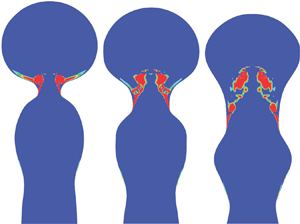Crossref Citations
This article has been cited by the following publications. This list is generated based on data provided by
Crossref.
Constante-Amores, C.R.
Batchvarov, A.
Kahouadji, L.
Shin, S.
Chergui, J.
Juric, D.
and
Matar, O.K.
2021.
Role of surfactant-induced Marangoni stresses in drop-interface coalescence.
Journal of Fluid Mechanics,
Vol. 925,
Issue. ,
Sen, Uddalok
Datt, Charu
Segers, Tim
Wijshoff, Herman
Snoeijer, Jacco H.
Versluis, Michel
and
Lohse, Detlef
2021.
The retraction of jetted slender viscoelastic liquid filaments.
Journal of Fluid Mechanics,
Vol. 929,
Issue. ,
Antonopoulou, E.
Harlen, O. G.
Rump, M.
Segers, T.
and
Walkley, M. A.
2021.
Effect of surfactants on jet break-up in drop-on-demand inkjet printing.
Physics of Fluids,
Vol. 33,
Issue. 7,
Constante-Amores, C.R.
Chergui, J.
Shin, S.
Juric, D.
Castrejón-Pita, J.R.
and
Castrejón-Pita, A.A.
2022.
Role of surfactant-induced Marangoni stresses in retracting liquid sheets.
Journal of Fluid Mechanics,
Vol. 949,
Issue. ,
Lohse, Detlef
2022.
Fundamental Fluid Dynamics Challenges in Inkjet Printing.
Annual Review of Fluid Mechanics,
Vol. 54,
Issue. 1,
p.
349.
Zhang, Yanzhen
Hu, Guofang
Liu, Yonghong
Wang, Jide
Yang, Guodong
and
Li, Dege
2022.
Suppression and Utilization of Satellite Droplets for Inkjet Printing: A Review.
Processes,
Vol. 10,
Issue. 5,
p.
932.
Liu, Xiao
Wagoner, Brayden W.
Wee, Hansol
and
Basaran, Osman A.
2022.
Effect of initial conditions on promotion and inhibition of breakup during filament contraction.
AIChE Journal,
Vol. 68,
Issue. 2,
Wee, Hansol
Wagoner, Brayden W.
and
Basaran, Osman A.
2022.
Spontaneous rupture of surfactant-covered thin liquid sheets.
Physical Review Fluids,
Vol. 7,
Issue. 9,
De Corato, Marco
Tammaro, Daniele
Maffettone, Pier Luca
and
Fueyo, Norberto
2022.
Retraction of thin films coated by insoluble surfactants.
Journal of Fluid Mechanics,
Vol. 942,
Issue. ,
Denner, Fabian
Evrard, Fabien
Castrejón-Pita, Alfonso Arturo
Castrejón-Pita, José Rafael
and
van Wachem, Berend
2022.
Reversal and Inversion of Capillary Jet Breakup at Large Excitation Amplitudes.
Flow, Turbulence and Combustion,
Vol. 108,
Issue. 3,
p.
843.
Liu, Xiao
Wagoner, Brayden W.
and
Basaran, Osman A.
2022.
Contraction velocity of viscoelastic filaments.
Physical Review Fluids,
Vol. 7,
Issue. 12,
Wee, Hansol
Anthony, Christopher R.
and
Basaran, Osman A.
2022.
Breakup of a low-viscosity liquid thread.
Physical Review Fluids,
Vol. 7,
Issue. 11,
Anthony, Christopher R.
Wee, Hansol
Garg, Vishrut
Thete, Sumeet S.
Kamat, Pritish M.
Wagoner, Brayden W.
Wilkes, Edward D.
Notz, Patrick K.
Chen, Alvin U.
Suryo, Ronald
Sambath, Krishnaraj
Panditaratne, Jayanta C.
Liao, Ying-Chih
and
Basaran, Osman A.
2023.
Sharp Interface Methods for Simulation and Analysis of Free Surface Flows with Singularities: Breakup and Coalescence.
Annual Review of Fluid Mechanics,
Vol. 55,
Issue. 1,
p.
707.
Valdes, Juan Pablo
Kahouadji, Lyes
Liang, Fuyue
Shin, Seungwon
Chergui, Jalel
Juric, Damir
and
Matar, Omar K.
2023.
On the dispersion dynamics of liquid–liquid surfactant-laden flows in a SMX static mixer.
Chemical Engineering Journal,
Vol. 475,
Issue. ,
p.
146058.
Liu, Langyu
Wang, He
Zhu, Chunying
Ma, Youguang
and
Fu, Taotao
2023.
Fragmentation of asymmetric liquid filaments and formation of satellite droplets in a microchannel.
International Journal of Multiphase Flow,
Vol. 158,
Issue. ,
p.
104290.
Yang, Zhengyu
Ji, Bingqiang
and
Feng, Jie
2023.
Daughter oil droplet entrainment by oil-coated bubble bursting.
Journal of Fluid Mechanics,
Vol. 977,
Issue. ,
Constante-Amores, C.R.
Kahouadji, L.
Shin, S.
Chergui, J.
Juric, D.
Castrejón-Pita, J.R.
Matar, O.K.
and
Castrejón-Pita, A.A.
2023.
Impact of droplets onto surfactant-laden thin liquid films.
Journal of Fluid Mechanics,
Vol. 961,
Issue. ,
Mayer, Michael D.
Kirk, Toby L.
and
Papageorgiou, Demetrios T.
2024.
Stability of a photosurfactant-laden viscous liquid thread under illumination.
Journal of Fluid Mechanics,
Vol. 983,
Issue. ,
Wang, Guozhen
Chen, Wei
Chen, Jiankui
Hu, Chao
Chen, Hao
and
Yin, Zhouping
2024.
Pinch-off dynamics of an electrohydrodynamic tip streaming jet transforming into the microdroplet.
Physics of Fluids,
Vol. 36,
Issue. 7,
Vega, E.J.
and
Montanero, J.M.
2024.
Influence of a surfactant on bubble bursting.
Experimental Thermal and Fluid Science,
Vol. 151,
Issue. ,
p.
111097.


